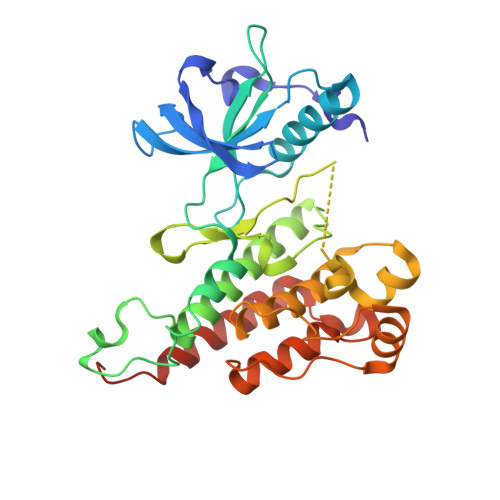Evolution of a Highly Selective and Potent 2-(Pyridin-2-yl)-1,3,5-triazine Tie-2 Kinase Inhibitor
Hodous, B.L., Geuns-Meyer, S.D., Hughes, P.E., Albrecht, B.K., Bellon, S., Bready, J., Caenepeel, S., Cee, V.J., Chaffee, S.C., Coxon, A., Emery, M., Fretland, J., Gallant, P., Gu, Y., Hoffman, D., Johnson, R.E., Kendall, R., Kim, J.L., Long, A.M., Morrison, M., Olivieri, P.R., Patel, V.F., Polverino, A., Rose, P., Tempest, P., Wang, L., Whittington, D.A., Zhao, H.(2007) J Med Chem 50: 611-626
- PubMed: 17253678
- DOI: https://doi.org/10.1021/jm061107l
- Primary Citation of Related Structures:
2P2H, 2P2I, 2P4I - PubMed Abstract:
Inhibition of angiogenesis is a promising and clinically validated approach for limiting tumor growth and survival. The receptor tyrosine kinase Tie-2 is expressed almost exclusively in the vascular endothelium and is required for developmental angiogenesis and vessel maturation. However, the significance of Tie-2 signaling in tumor angiogenesis is not well understood. In order to evaluate the therapeutic utility of inhibiting Tie-2 signaling, we developed a series of potent and orally bioavailable small molecule Tie-2 kinase inhibitors with selectivity over other kinases, especially those that are believed to be important for tumor angiogenesis. Our earlier work provided pyridinyl pyrimidine 6 as a potent, nonselective Tie-2 inhibitor that was designed on the basis of X-ray cocrystal structures of KDR inhibitors 34 (triazine) and 35 (nicotinamide). Lead optimization resulted in pyridinyl triazine 63, which exhibited >30-fold selectivity over a panel of kinases, good oral exposure, and in vivo inhibition of Tie-2 phosphorylation.
- Department of Medicinal Chemistry, Amgen Inc., One Kendall Square, Building 1000, Cambridge, Massachusetts 02139-1581, USA. bhodous@amgen.com
Organizational Affiliation:


















